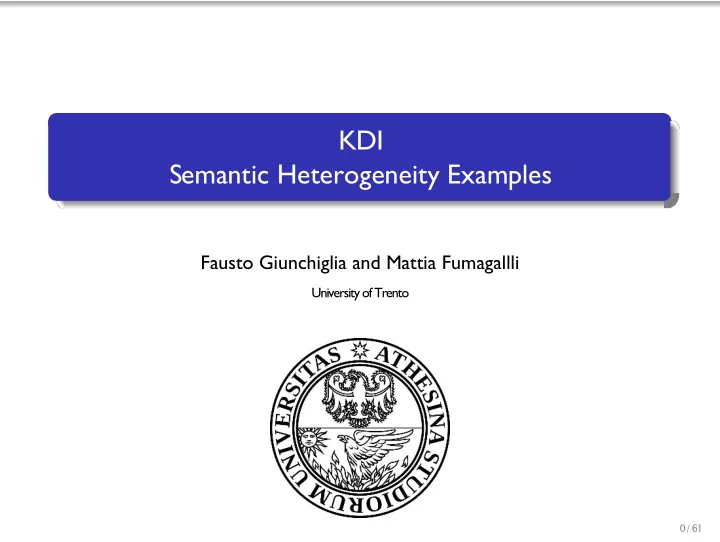

KDI Semantic Heterogeneity Examples Fausto Giunchiglia and Mattia Fumagallli University of Trento 0/61
Open Data Projects Open data is data that anyone can access, use or share. Simple as that. When big companies or governments release non-personal data, it enables small businesses, citizens and medical researchers to develop resources which make crucial improvements to their communities. 1/61
Open Government Data Various governmental departments as part of their daily activities, produce, manage and store large volume of authentic and interesting data Why opening data?: great economic value strong potential for supporting innovation transparency and participation improving organizational and communication efficiency support data-centric applications Not all of this data can be made publicly available because of the constraints such as: privacy issues intellectual property rights national security concerns 2/61
Open Data Vs. Big Data Open in Open Data is about the modality by which data are made available. Big in big data is about the 5v which define the characteristics of data which are made available. The definition of Big Data as provided by Gartner is “ Big Data is high- volume, high-velocity and high-variety information assets that demand cost-effective, innovative forms of information processing for enhanced insight and decision making ”. 3/61
Open Research Data in HORIZON 2020 4/61
Open Data In Education 5/61
Famous Open Data Projects 6
GeoNames GeoNames provide a rich source of information for geographical data. It contains millions of geographical names and unique features, such as mountain, city and airport. GeoNames provides spatial properties (e.g. longitude, latitude) as well as non-spatial properties (e.g. population) of spatial entities, but it lacks in support for accommodating diverse data sources. http://www.geonames.org 7/61
OpenStreetMap (OSM) OpenStreetMap ( OSM ) is a collaborative project to create a free editable map of the world. Two major driving forces behind the establishment and growth of OSM have been restrictions on use or availability of map information across much of the world and the advent of inexpensive portable satellite navigation devices. OSM is considered a prominent example of volunteered geographic information. --Wikipedia https://www.openstreetmap.org 8/61
LinkedGeoData LinkedGeoData (LGD) is the RDF (resource description framework) data dump of OpenStreetMaps (OSM) entities. Concept disambiguation (i.e., diversity in the nomenclature) and ontological correctness of the model have been overlooked in this geospatial resource. http://browser.linkedgeodata.org 9/61
Wiktionary Wiktionary (whose name is a blend of the words wiki and dictionary) is a multilingual, web-based project to create a free content dictionary of all words in all languages. It is available in 172 languages and in Simple English. It is written collaboratively by volunteers, dubbed "Wiktionarians". Its wiki software, MediaWiki, allows almost anyone with access to the website to create and edit entries https://en.wiktionary.org/wiki/Wiktionary:Main_Page 10/61
WikiData Free. The data in Wikidata is published under the Creative Commons Public Domain Dedication 1.0, allowing the reuse of the data in many different scenarios. Collaborative. The data in Wikidata is entered and maintained by Wikidata editors, who decide on the rules of content creation and management in Wikidata. Multilingual. Editing, consuming, browsing, and reusing the data is fully multilingual. https://www.wikidata.org/wiki/Wikidata:Main_Page 11/61
WikiPedia Wikipedia is a free encyclopedia, written collaboratively by the people who use it. It is a special type of website designed to make collaboration easy, called a wiki. Many people are constantly improving Wikipedia, making thousands of changes per hour. 12/61
DBPedia DBpedia (from "DB" for "database") is a project aiming to extract structured content from the information created as part of the Wikipedia project. This structured information is then made available on the World Wide Web 13/61
FreeBase Freebase was a large collaborative knowledge base consisting of data composed mainly by its community members. It contains data harvested from several sources such as Wikipedia, MusicBrainz, as well as individually contributed data from its users. 14/61
Yago YAGO is a huge semantic knowledge base, derived fromWikipediaWordNet and GeoNames. Currently, YAGO has knowledge of more than 10 million entities (like persons, organizations, cities, etc.) and contains more than 120 million facts about these entities. https://gate.d5.mpi-inf.mpg.de/webyago3spotlx/SvgBrowser 15/61
Open Data Sources 16/61
EU open Data Portal The European Data Portal harvests the metadata of Public Sector Information available on public data portals across European countries. Information regarding the provision of data and the benefits of re-using data is also included. https://www.europeandataportal.eu 17/61
Browse Categories in EU Open Data 18/61
Data domains with the most datasets Transportation is among the most interesting data categories for all the cities included. 19/61
Open Data Trentino Open data trentino portal harvests the metadata of Public Sector Information available on public data portals in Trentino region. http://dati.trentino.it 20/61
Open Data Trentino CKAN is a powerful data management system that makes data accessible – by providing tools to streamline publishing , sharing, finding and using data. CKAN is aimed at data publishers (national and regional governments, companies and organizations) wanting to make their data open and available. . http://ckan.org 21/61
Open Data Market Figure – Total market size (high bound), split in direct and indirect size for EU28+in billions, 2016-2020 https://www.europeandataportal.eu/ 22/61
Market Size Figure – Direct market size of Open Data per market sector for EU28+ in millions, 2020 https://www.europeandataportal.eu/ 23/61
Benefit of Open Data https://www.europeandataportal.eu/ 24/61
Houghton, formula for estimating cost-benefits https://www.europeandataportal.eu/ 25/61
Innovation and growth in businesses Open data is supporting innovation and growth by revealing opportunities for businesses large and small to build new services, identify savings and improve operations. In Paris, café owners are using open data to attract tourists to the city's most affordable coffees, while, in Iceland, farmers are using open data about the quality of their lambs to attract new customers https://www.google.com/maps/d/viewer?mid=1F2BRo2yYU2YM8Sy8jrtZtRIW1Es&hl=en_US 26/61
Open Move https://www.youtube.com/watch?v=ZjSD06sVrzg 27/61
Benefiting culture and the environment Open data helps farmers to improve yields and support a growing population without the need to destroy valuable habitats. Plantwise are collecting open data to produce valuable information packs for farmers about plant health and threats from diseases. https://www.plantwise.org 28/61
LOV: Linked Open Vocabulary http://lov.okfn.org/dataset/lov/ 29/61
Recommend
More recommend